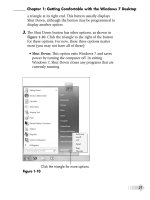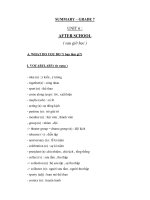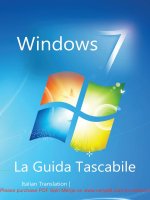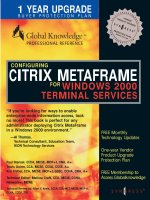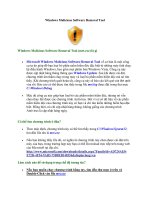Tài liệu Windows Phone 7 Game Development ppt
Bạn đang xem bản rút gọn của tài liệu. Xem và tải ngay bản đầy đủ của tài liệu tại đây (10.81 MB, 593 trang )
Discover the world of 2D and 3D game programming in C#
with XNA and Silverlight for Windows Phone 7 devices
Windows Phone 7
Game Development
Adam Dawes
www.it-ebooks.info
www.it-ebooks.info
i
Windows Phone 7
Game Development
■ ■ ■
Adam Dawes
www.it-ebooks.info
ii
Windows Phone 7 Game Development
Copyright © 2010 by Adam Dawes
All rights reserved. No part of this work may be reproduced or transmitted in any form or by any
means, electronic or mechanical, including photocopying, recording, or by any information
storage or retrieval system, without the prior written permission of the copyright owner and the
publisher.
ISBN-13 (pbk): 978-1-4302-3306-0
ISBN-13 (electronic): 978-1-4302-3307-7
Printed and bound in the United States of America 9 8 7 6 5 4 3 2 1
Trademarked names, logos, and images may appear in this book. Rather than use a trademark
symbol with every occurrence of a trademarked name, logo, or image we use the names, logos, and
images only in an editorial fashion and to the benefit of the trademark owner, with no intention of
infringement of the trademark.
The use in this publication of trade names, trademarks, service marks, and similar terms, even if
they are not identified as such, is not to be taken as an expression of opinion as to whether or not
they are subject to proprietary rights.
President and Publisher: Paul Manning
Lead Editors: Mark Beckner, Ewan Buckingham
Technical Reviewer: Don Sorcinelli
Editorial Board: Steve Anglin, Mark Beckner, Ewan Buckingham, Gary Cornell, Jonathan
Gennick, Jonathan Hassell, Michelle Lowman, Matthew Moodie, Duncan Parkes, Jeffrey
Pepper, Frank Pohlmann, Douglas Pundick, Ben Renow-Clarke, Dominic Shakeshaft, Matt
Wade, Tom Welsh
Coordinating Editor: Mary Tobin
Copy Editor: Nancy Sixsmith
Compositor: MacPS, LLC
Indexer: Brenda Miller
Artist: April Milne
Cover Designer: Anna Ishchenko
Distributed to the book trade worldwide by Springer Science+Business Media, LLC., 233 Spring
Street, 6th Floor, New York, NY 10013. Phone 1-800-SPRINGER, fax (201) 348-4505, e-mail
, or visit www.springeronline.com.
For information on translations, please e-mail , or visit www.apress.com .
Apress and friends of ED books may be purchased in bulk for academic, corporate, or promotional
use. eBook versions and licenses are also available for most titles. For more information, reference
our Special Bulk Sales–eBook Licensing web page at www.apress.com/info/bulksales .
The information in this book is distributed on an “as is” basis, without warranty. Although every
precaution has been taken in the preparation of this work, neither the author(s) nor Apress shall
have any liability to any person or entity with respect to any loss or damage caused or alleged to be
caused directly or indirectly by the information contained in this work.
The source code for this book is available to readers at www.apress.com.
www.it-ebooks.info
iii
For Ritu and Kieran.
www.it-ebooks.info
iv
Contents at a Glance
■Contents v
■About the Author xix
■About the Technical Reviewer xx
■Acknowledgments xxi
■Introduction xxii
Part I: The Beginning 1
■Chapter 1: Windows Phone and .NET 3
Part II: XNA 21
■Chapter 2: Getting Started with XNA 23
■Chapter 3: Creating a Game Framework 59
■Chapter 4: User Input 99
■Chapter 5: Sounding Out with Game Audio 147
■Chapter 6: Drawing with Vertices and Matrices 159
■Chapter 7: The World of 3D Graphics 211
■Chapter 8: Further 3D Features and Techniques 257
■Chapter 9: Enhancing Your Game 313
■Chapter 10: The Application Life Cycle 333
Part III: Silverlight 351
■Chapter 11: Getting Started with Silverlight 353
■Chapter 12: Silverlight Controls and Pages 389
■Chapter 13: Gaming with Silverlight 423
■Chapter 14: Enhancing Your Silverlight Games 463
Part IV: Distribution 495
■Chapter 15: Distributing Your Game 497
■Chapter 16: Running on Other Platforms 517
■Index 539
www.it-ebooks.info
v
Contents
■Contents at a Glance iv
■About the Author xix
■About the Technical Reviewer xx
■Acknowledgments xxi
■Introduction xxii
Part I: The Beginning 1
■Chapter 1: Windows Phone and .NET 3
Looking Closely at Visual Studio Development for Windows Phone 4
Language Choices 5
IDE Features 5
Windows Phone Platform 7
Using Visual Studio for Windows Phone Development 9
Installing Visual Studio 9
Creating a Windows Phone Project 11
Designing a Page 12
Running the Application 14
Running on a Real Device 14
Getting Help 18
Windows Phone Game Development 19
Suitable Games 19
Selecting an Application Framework 19
www.it-ebooks.info
■ CONTENTS
vi
Welcome to the World of Windows Phone Development 20
Part II: XNA 21
■Chapter 2: Getting Started with XNA 23
What Is XNA? 23
Your First XNA Project 24
Creating the Project 24
Adding Some Content 25
Displaying the Graphic 26
Moving the Graphic 29
Examining the Solution in More Detail 31
Sprites in Detail 34
Supported Graphic Formats 34
Scaling 35
Rotation 37
Tinting 38
Partial Image Rendering 40
Layer Depth 41
Sprite Transparency 42
Alpha Tinting 44
Useful Sprite Effects 45
Setting a Background Image 45
Fading to Black 46
Fading between Images 48
Displaying Text 49
Font Support 49
Creating SpriteFont Objects 51
Displaying Text 52
Other Graphics Options 55
Rendering in Full Screen Mode 55
Supporting Portrait and Landscape Orientations 55
www.it-ebooks.info
■ CONTENTS
vii
Graphic Scaling 57
Suppressing Drawing 58
Experiment and Play with XNA 58
■
Chapter 3: Creating a Game Framework 59
Designing the Game Framework 59
The GameObjectBase Class 60
The SpriteObject Class 60
The TextObject Class 64
The GameHost Class 66
The GameHelper Class 71
Using the Game Framework 71
Referencing the GameFramework Project 72
Setting Inheritance for the Main Game Class 73
Creating Derived SpriteObject Classes 73
Adding Game Objects to the Game Host 78
Removing Objects from the Game Host 80
Overriding Object Properties 80
Benchmarking and Performance 83
The BenchmarkObject Class 84
Using BenchmarkObject 85
Performance Considerations 86
Game in Focus: Cosmic Rocks (Part I) 89
Designing the Game 90
Creating the Graphics 90
Creating the Game Objects 91
Running the Game 97
Creating XNA Games 98
■Chapter 4: User Input 99
Using the Touch Screen 99
Reading Raw Touch Data 100
www.it-ebooks.info
■ CONTENTS
viii
Reading Input Using the Touch Gestures 103
Sprite Hit Testing 108
Initiating Object Motion 119
Finger-Friendly Gaming 123
Reading the Keyboard and Text Input 124
Using a Hardware Keyboard 124
Prompting the User to Enter Text 127
Reading the Accelerometer 129
Initializing the Accelerometer 129
Using the Accelerometer Data 131
Simulating the Accelerometer in the Emulator 132
Game in Focus: Cosmic Rocks (Part II) 133
Making the Player’s Ship Shoot 134
Making the Player’s Ship Move 141
Implementing Hyperspace 143
Considering Input Design 145
■Chapter 5: Sounding Out with Game Audio 147
Sound Effects and Music 147
Playing Sound Effects 147
Adding Sound Effects to your Project 148
Playing the Sound Effects 149
Integrating Sound Effects into the Game Framework 150
Sound Effect Instances 150
Other Sound Effect Properties 152
Obtaining Sound Effects for your Game 152
An Interactive Example 153
Playing Music 153
To Play or Not To Play 153
Adding Music to your Project 154
Playing the Music 155
www.it-ebooks.info
■ CONTENTS
ix
Game in Focus: Cosmic Rocks (Part III) 157
Make Some Noise 158
■Chapter 6: Drawing with Vertices and Matrices 159
A New Approach to Drawing 159
Matrix-Based Positioning 159
Abstract Coordinate System 160
Drawing Primitives 160
Textures 161
XNA is a State Engine 161
Creating our First Vertex Rendering Project 161
Setting Up the Environment 162
Rendering the Object 164
Moving the Object 166
Adding some Sparkle 167
Tinting Objects 168
Understanding Matrix Transformations 169
Setting the Identity Matrix 169
Applying Translation Transformations 170
Applying Rotation Transformations 171
Applying Scaling Transformations 172
Applying Multiple Transformations 173
Specifying Vertex Positions 176
Drawing Multiple Objects at Different Positions 176
Drawing Primitives 178
Drawing Lines 178
Drawing Triangles 179
Drawing Points 181
Applying Textures 181
Loading Graphics 181
Setting the Active Texture 182
www.it-ebooks.info
■ CONTENTS
x
Applying the Texture to an Object . 182
Preparing the Effect for Texture Mapping . 185
Configuring the Sampler State . 187
Supported Texture Image Formats . 190
Using Different Textures Within the Same Draw Call . 190
Using Transparency and Alpha Blending . 191
Enabling and Disabling Alpha Blending . 192
XNA’s Built-In Blend States 192
Creating Custom Blend States . 195
Object Transparency 199
Handling Orientations . 199
Graphic Scaling . 201
Integration into the Game Framework . 201
The MatrixObjectBase Class . 202
Updates to the GameHost Class . 207
Using the Game Framework for Matrix Rendering . 209
Enter the Matrix . 209
■Chapter 7: The World of 3D Graphics . 211
Perspective Projection 211
The Viewing Frustum 211
Defining the Viewing Frustum in XNA . 215
Rendering 3D Objects . 216
Defining a 3D Object 216
The Depth Buffer . 219
Enabling and Disabling the Depth Buffer . 220
Clearing the Depth Buffer 222
Rendering Transparent Objects with the Depth Buffer . 222
Hidden Surface Culling . 223
Vertex and Index Buffers 226
Download from Wow! eBook <www.wowebook.com>
www.it-ebooks.info
■ CONTENTS
xi
Using Vertex Buffers 226
Using Indexed Vertices 228
Using Vertex Buffers and Indexing Together 230
Lighting 232
Lights and Materials 232
Types of Illumination 232
Material Properties 234
Light and Material Interaction 235
Using Multiple Lights 236
Reusing Lights 236
Types of Light Source 236
How XNA Calculates Light Reflections 237
Adding Lighting to Games 242
Orthographic Projection 250
The Viewing Frustum 250
Defining the Orthographic Viewing Frustum in XNA 252
Isometric Projection 253
Pixel-Aligned Projection 255
Mastering the 3D World 256
■Chapter 8: Further 3D Features and Techniques 257
Importing Geometry 257
SketchUp 258
Importing Saved Geometry into XNA Projects 261
Rendering Imported Geometry 263
Adding Support into the Game Framework 266
The Google SketchUp 3D Warehouse 268
Importing Other File Formats 269
Working with the Camera 269
Camera Position and Orientation 269
Integrating Camera Support into the Game Framework 271
www.it-ebooks.info
■ CONTENTS
xii
Creating a Chase Cam 274
Adding Fog 284
Adding a Skybox 285
Creating Skyboxes 286
Implementing the Skybox into the Game Framework 287
Particles 290
How Particles are Implemented 290
Billboarding 290
Adding Particle Support to the Game Framework 292
Creating Fire and Smoke 292
Vapor and Smoke Trails 294
Fairy Dust 295
Using Effect Objects 296
Effect Capabilities 297
AlphaTestEffect 298
DualTextureEffect 300
EnvironmentMapEffect 304
SkinnedEffect 308
Mixing Sprite and Matrix Rendering 308
A Universe of Possibilities 311
■Chapter 9: Enhancing Your Game 313
Managing Game Settings 313
Class Structure 314
Setting and Retrieving Values 314
Displaying a Settings Screen 316
Creating the Settings User Interface 318
Planning a Game’s Navigation Model 322
Adding a High Score Table 323
Implementing the High Score Table 324
Using the HighScore Classes in a Game 330
www.it-ebooks.info
■ CONTENTS
xiii
Reusing Game Components 332
■
Chapter 10: The Application Life Cycle 333
The Effects of Losing Focus 333
Life Cycle Events 334
The Launching Event 335
The Closing Event 335
The Deactivated Event 335
The Activated Event 336
Handling the Life Cycle Events 336
Seeing the Events in Action 337
Persisting Session State 338
Controlling Serialization 340
DataContracts and Inheritance 341
Persisting Nonserializable Data 342
Tombstoning in the Game Framework 343
Setting up the GameHost Event Handlers 343
Preparing the Classes for Serialization 344
Persisting Content References 344
Automatic Storage and Retrieval of Game Objects in the State Dictionary 347
Identifying Specific Objects After Tombstoning 348
Game Initialization 349
Troubleshooting Serialization 349
Returning from the Grave 349
Part III: Silverlight 351
■Chapter 11: Getting Started with Silverlight 353
A Brief History of Silverlight 353
Windows Presentation Foundation 353
Silverlight 354
Silverlight on Windows Phone 355
www.it-ebooks.info
■ CONTENTS
xiv
Creating Silverlight Projects for Windows Phone 355
Choosing a Project Template 356
Working with Silverlight Projects 358
Examining the Solution in More Detail 359
Referencing Other Projects 361
Exploring XAML 362
What Is XAML For? 362
The Silverlight Page Structure 363
XAML’s Syntax 364
Working with the Page Designer 371
Adding and Positioning Elements 371
The Document Outline Window 372
Using the Properties Window 373
Understanding Control Alignment 376
Colors and Brushes 378
Color Specifications 378
Brushes 379
Setting Colors in Code 386
Using Brushes Together 387
Exploring Silverlight 388
■Chapter 12: Silverlight Controls and Pages 389
The Silverlight Controls 389
Display Controls 389
Interactive Controls 395
Layout Controls 401
User Interface Design 409
Using Control Transforms and Projections 409
Using RotateTransform 409
Using ScaleTransform 411
Using SkewTransform 411
www.it-ebooks.info
■ CONTENTS
xv
Using TranslateTransform 412
Using TransformGroups 412
Using CompositeTransform 413
Using Projection 414
Orientation 416
Running in Full Screen Mode 417
Multipage Projects 417
Adding New Pages to a Project 418
Navigating Between Pages 419
Passing Values When Navigating 420
Game On… 421
■Chapter 13: Gaming with Silverlight 423
Creating Sprites 423
Sprite User Control 423
Sprite Image Handling 425
Positioning the Sprite 430
Sprite Transformations 431
Adding Sprites to a Silverlight Page 431
Creating Sprites at Runtime 433
Sprite Examples 434
Sprite Movement 436
Procedural Animation 436
Storyboard Animation 439
Silverlight Performance 446
Reading the Frame Rate Counters 446
Using Cache Visualization 448
Viewing Redraw Regions 449
User Input 449
Control Events 449
Touch Events 452
www.it-ebooks.info
■ CONTENTS
xvi
Gestures 454
Accelerometer 456
Game in Focus: Diamond Lines, Part I 457
Sprite Configuration 458
Game Flow 459
Input Processing 460
Sprite Animation 461
Using Silverlight for Game Development 462
■Chapter 14: Enhancing Your Silverlight Games 463
Game Navigation 463
Defining the Navigation Flow 464
Redirecting Navigation 465
Implementing the Navigation Flow 466
Navigating Between Pages 469
Maintaining Game State 470
Game Settings 472
Creating a High Score Table 474
The High Score Table Classes 474
Instantiating the HighScores Object 476
Adding New Score Entries 477
Displaying the Scores 478
Playing Music and Sound Effects 479
Accessing the XNA Audio Library 480
Initializing the XNA Dispatch Timer 480
Playing Sound Effects 481
Playing Music 484
Application Life Cycle 485
Exploring Tombstoning Behavior in Silverlight 486
Storing and Restoring State 486
Game in Focus: Diamond Lines, Part II 488
www.it-ebooks.info
■ CONTENTS
xvii
Adding Game Navigation 488
Maintaining Game State 488
Tombstoning Support 490
Adding Game Settings 492
Implementing the Sound Effects 493
Gaming with Silverlight 494
Part IV: Distribution 495
■Chapter 15: Distributing Your Game 497
Testing Your Game 497
Trial Mode 498
Detecting Trial Mode 499
Purchasing the Full Version 502
Offering Promotional Upgrades 503
Submission Requirements 504
Content Policies 504
Application Requirements 504
Localization 504
Application Features 504
Reliability and Performance 505
Technical Information 505
Music and Sound 505
Preparing for Distribution 506
Setting the Assembly Information 506
Setting the Assembly Version 507
Setting the Project Properties 509
Setting the Manifest Properties 510
Providing Graphics Files 510
Compiling the Game 511
Selling or Giving Your Game for Free 511
Submitting Your Game to the Marketplace 512
www.it-ebooks.info
■ CONTENTS
xviii
Promoting Your Game 513
Capturing Your Game in Motion 513
Editing Your Video Clip 515
Go Create! 516
■Chapter 16: Running on Other Platforms 517
Running XNA Projects in Windows 517
Porting Projects to Windows 518
Using Conditional Compilation 520
Project Differences 521
Display Differences 521
Input Differences 524
Isolated Storage 526
Application Life Cycle 526
Converting the Game Framework to Run on Windows 526
Trial Mode 529
Distribution 529
Revisiting Some Example Projects 530
Developing Games for Windows Phone 7 and Windows 531
Running Silverlight Projects in the Browser 531
Differences between Silverlight and Silverlight for Windows Phone 532
Converting Projects from Windows Phone 7 532
Example Projects 537
Let’s Play… 538
■Index 539
www.it-ebooks.info
xix
About the Author
■ Adam Dawes is a software developer and systems architect working at a cutting-
edge online service development company.
He has been a compulsive programmer since the age of four, when he was first
introduced to a monochrome Commodore PET. The love affair has continued
through three subsequent decades, flourishing through the days of the 8-bit dinosaurs
to today’s era of multicore processors and pocket supercomputers.
A constant throughout Adam’s career has been his fondness for computer games.
From the very first time Nightmare Park displayed its devious maze of pathways in
green symbols back in 1980, he has been a games player across a variety of genres and
styles. These days, he spends his spare time playing the latest 3D titles on his PC, or
enjoying some of the classics in his stand-up arcade machine or sit-in cockpit driving cabinet. Creating
his own games has always been a hobby and, while he has no intention of becoming part of the
professional games industry, he has a lot of fun developing his own titles.
Adam lives with his wife Ritu and son Kieran in southeast England. His web site is at
www.adamdawes.com (all his finished projects can be downloaded there) and he can be emailed at
He would particularly like to see the results of your own game development
projects.
www.it-ebooks.info
■ CONTENTS
xx
About the Technical Reviewer
■ Don Sorcinelli has been involved with planning, developing, and deploying enterprise applications
for over 15 years. His involvement in these processes expanded to include the PDA platforms starting in
the late 1990s. He is currently a Product Engineer focused on Mobile Device Management solutions.
Don frequently presents on Windows Mobile topics for users, developers, and IT professionals. As a
result, he was awarded Most Valuable Professional status for Windows Mobile Devices by Microsoft
Corporation in January 2004 for his work with the Windows Mobile community.
Currently, Don is co-manager of the Boston/New England Windows Mobile User and Developer
Group, and webmaster of BostonPocketPC.com (). He can be contacted
at
Download from Wow! eBook <www.wowebook.com>
www.it-ebooks.info
xxi
Acknowledgments
I must start by thanking my parents for all the opportunities they gave me when I was growing up and
for encouraging my computer habit from a very young age.
Thank you to everyone at Apress for their assistance in getting this book written and delivered; in
particular to Mark Beckner for allowing me the opportunity in the first place, to Mary Tobin for her
tireless assistance and encouragement, and to Nancy Sixsmith for making the book much more readable
and for putting up with correcting the same grammatical errors over and over again.
I owe thanks, too, to Don Sorcinelli for his invaluable input throughout the whole book, and to Mike
Ormond for arranging for me to get my hands on a real live Windows Phone 7 device during the writing
of the book.
And finally, of course, thanks without end to my wife Ritu and my son Kieran, for their constant
encouragement and for tolerating my shutting myself in my study and writing every evening and
weekend. I’ll be spending much more time with you both now, I promise!
www.it-ebooks.info
■ INTRODUCTION
xxii
Introduction
This Goal of This Book
Gaming on the move has become very popular during recent years. With the arrival of the Nintendo
Gameboy, people realized that they could take their games out and about with them, and as technology
has become more sophisticated these games have grown, too. They now encompass complex game
mechanics, advanced 2D and 3D graphics, and engrossing stories and game worlds that the player can
literally become lost in.
Alongside this phenomenon is the explosion in popularity of mobile communication devices.
Nearly everyone carries a phone with them every time they leave the house. These devices have become
much more than just phones, however; they provide contact management, e-mail, web browsing,
satellite navigation, and entertainment.
Writing games for mobile devices allows both these trends to be brought together into the same
place. It is very easy for people to “pick up and play” a game on their mobile device as they always have it
in their pocket—whether they are progressing through a sprawling role-playing game on a train or
simply want the few minutes of casual diversion that mobile gaming can provide while waiting for an
appointment.
Windows Phone 7 Game Development aims to bring you the knowledge and techniques that you will
need to create your own games for devices running the Microsoft’s powerful Windows Phone 7
operating system. Starting with the basics of the platform and its development environment, and
progressing through to advanced topics such as 3D graphics, it will guide you step by step toward
creating a simple and manageable environment into which you can write your own mobile games and
distribute them to the world for fun or profit. Example projects are provided to demonstrate all the
techniques discussed and are ideal as a basis for experimentation.
Both of the application environments supported by Windows Phone 7 are addressed, exploring how
games can be produced in the dedicated gaming environment, XNA, and also in the more general-
purpose and user-interface-driven Silverlight.
Who This Book Is For
This book is written for those who are already familiar with programming one of the two main managed
Visual Studio languages: C# or Visual Basic.NET. It is assumed that you already have a grasp of the
fundamentals of programming and are familiar with using the environment for PC-based application
development. This is not an introduction to programming or to Visual Studio itself.
You will, however, be given a complete guide to setting up the development environment for
Windows Phone 7 programming, getting your first programs to compile, and interactively debugging
your games as they run either on the Windows Phone 7 emulator included with the phone’s free
software development kit or on a real device.
In order to develop software for your device, you will need to use the Visual Studio 2010
development environment. If you already have Visual Studio 2010, you can integrate the Windows
Phone 7 development tools into your existing environment; if you do not have it, you can obtain Visual
www.it-ebooks.info
■ INTRODUCTION
xxiii
Studio 2010 Express for Windows Phone free of charge via a simple download from the Microsoft web
site.
Although most of the projects in the book can be developed using the provided emulator, it is
strongly recommended that you also have access to a real device to test your games.
The examples in this book are all written using C#, the only development language fully supported
for Windows Phone 7 development. Developers who are more familiar with VB.NET should find that the
language code and concepts translate over to C# fairly easily, so this should not present too much of a
barrier to entry.
Chapter Overview
The following is a brief description of each chapter. The chapters tend to build on one another, so it is
recommended that you read them in sequence to avoid knowledge gaps in later chapters.
Chapter 1 introduces Windows Phone 7 and using the Visual Studio 2010 development environment
to create Windows Phone 7 games and applications. It explains how to set up simple .NET projects
running against the emulator and real devices, explores debugging techniques, and begins to look at the
two application environments: XNA and Silverlight.
Chapter 2 dives into XNA, exploring in detail the structure of XNA projects, the approach to
displaying and updating graphics, how sprites can be used to create complex 2D graphics output, and
how to work with fonts and text.
Chapter 3 takes the concepts explored so far and builds them into a simple reusable game
framework that simplifies many of the tedious elements of setting up a game project. This allows you to
focus on the game itself rather than getting weighed down with object management. This chapter also
introduces the first of the example game projects in this book: Cosmic Rocks.
Chapter 4 covers the subject of user input. All sorts of input devices are available on Windows
Phone 7 devices, from touch screens and keyboards through to accelerometers, and they are explored in
detail to show how they can be used to allow your games to be controlled.
Chapter 5 turns up the volume and reveals the options for game audio. Covering simple sound
effects to MP3 music playback, everything you need to know about sound for your games can be found
here.
Chapter 6 begins to explore rendering with vertices and matrices instead of using sprites. Matrix
transformations are uncovered and explained so that graphics can be rotated, scaled, and translated;
and concepts such as texture mapping, blending, and alpha effects in this environment are explored.
Chapter 7 lifts the XNA feature set up into the third dimension, explaining how to create 3D game
worlds. Subjects covered include perspective and orthographic projections, the depth buffer, and
lighting so that your scenes really come to life.
Chapter 8 continues the exploration of XNA in the third dimension and introduces a number of
useful new rendering features. These features include importing 3D objects from third-party modeling
packages, moving and manipulating the camera within a game world, using particle effects, creating
background imagery with sky boxes, applying fog to a 3D scene, and using XNA’s Effect objects to add
new features and capabilities to your game.
Chapter 9 provides some useful reusable components that can be used in any game. A simple
mechanism for loading and saving user settings and a high-score table implementation are provided to
allow you to focus on writing your game rather than having to reinvent these features yourself.
Chapter 10 exposes the Windows Phone 7 application life cycle and tombstoning, an essential topic
that you will need to get to grips with so that your game can live side by side with other applications that
the user chooses to open on their device.
Chapter 11 moves away from XNA and begins to explore Windows Phone 7’s other application
environment: Silverlight. While not specifically geared around games, Silverlight still has plenty of
capabilities and great potential for game development. This chapter introduces the environment and
explores how it is used.
www.it-ebooks.info
